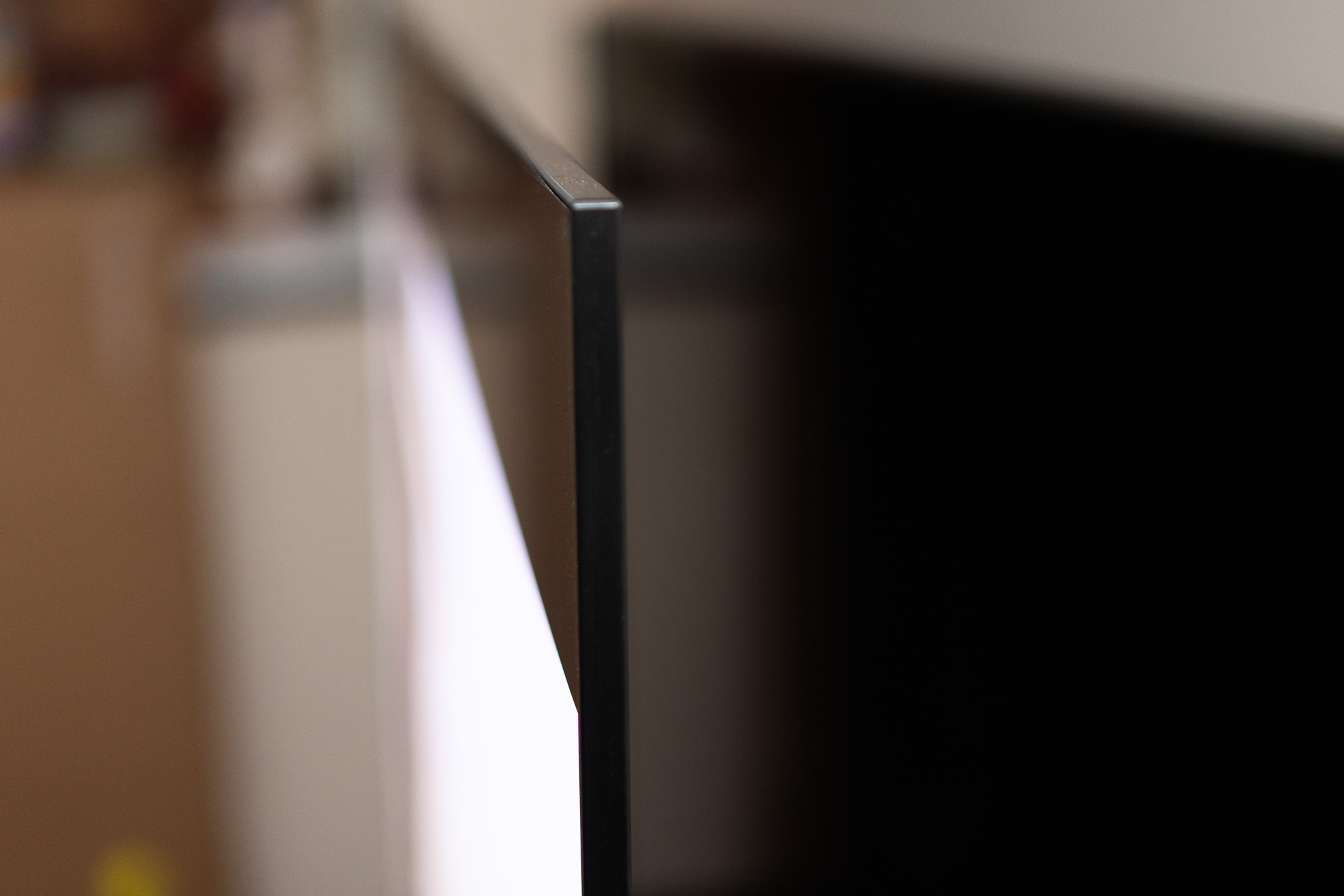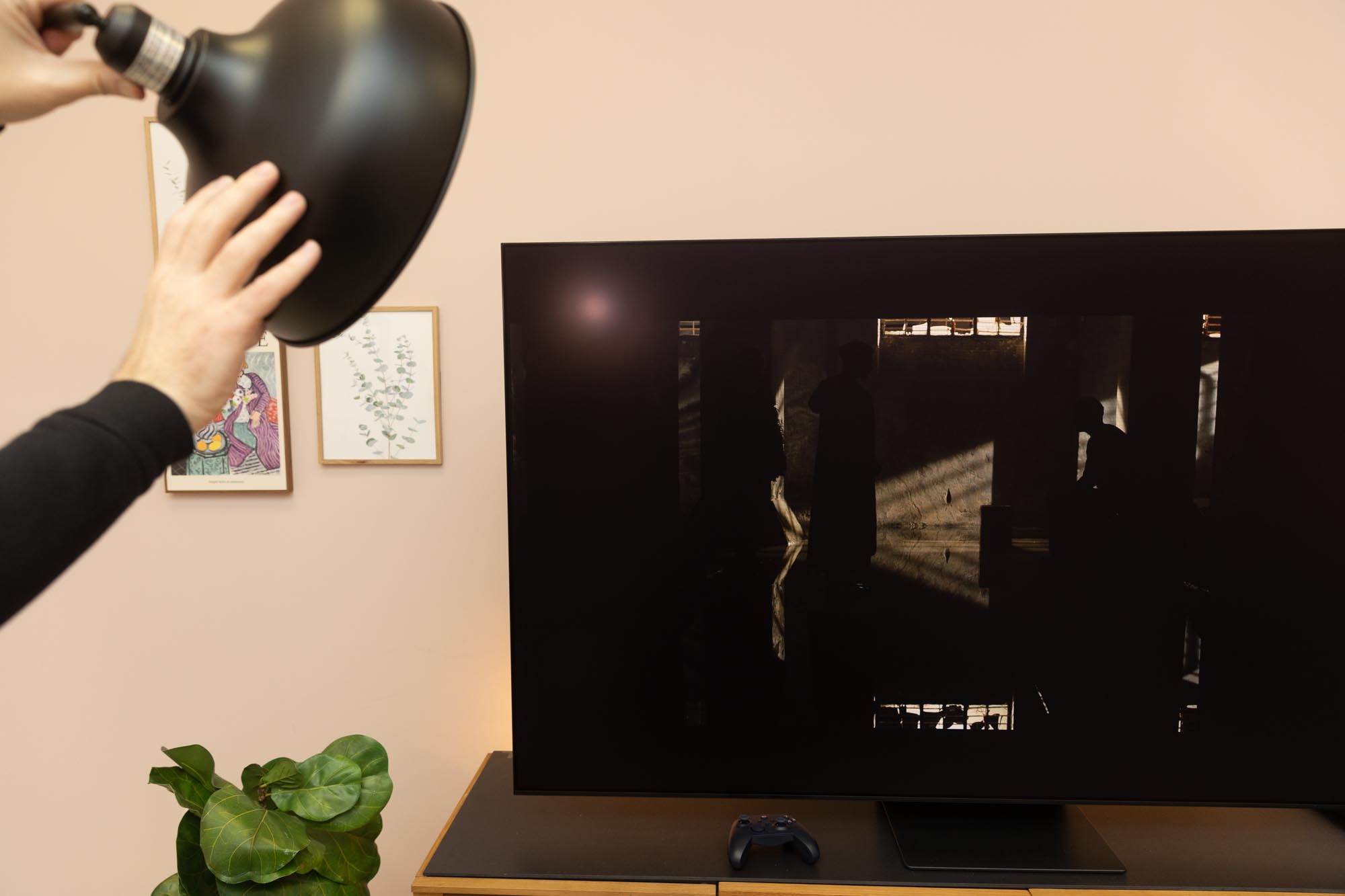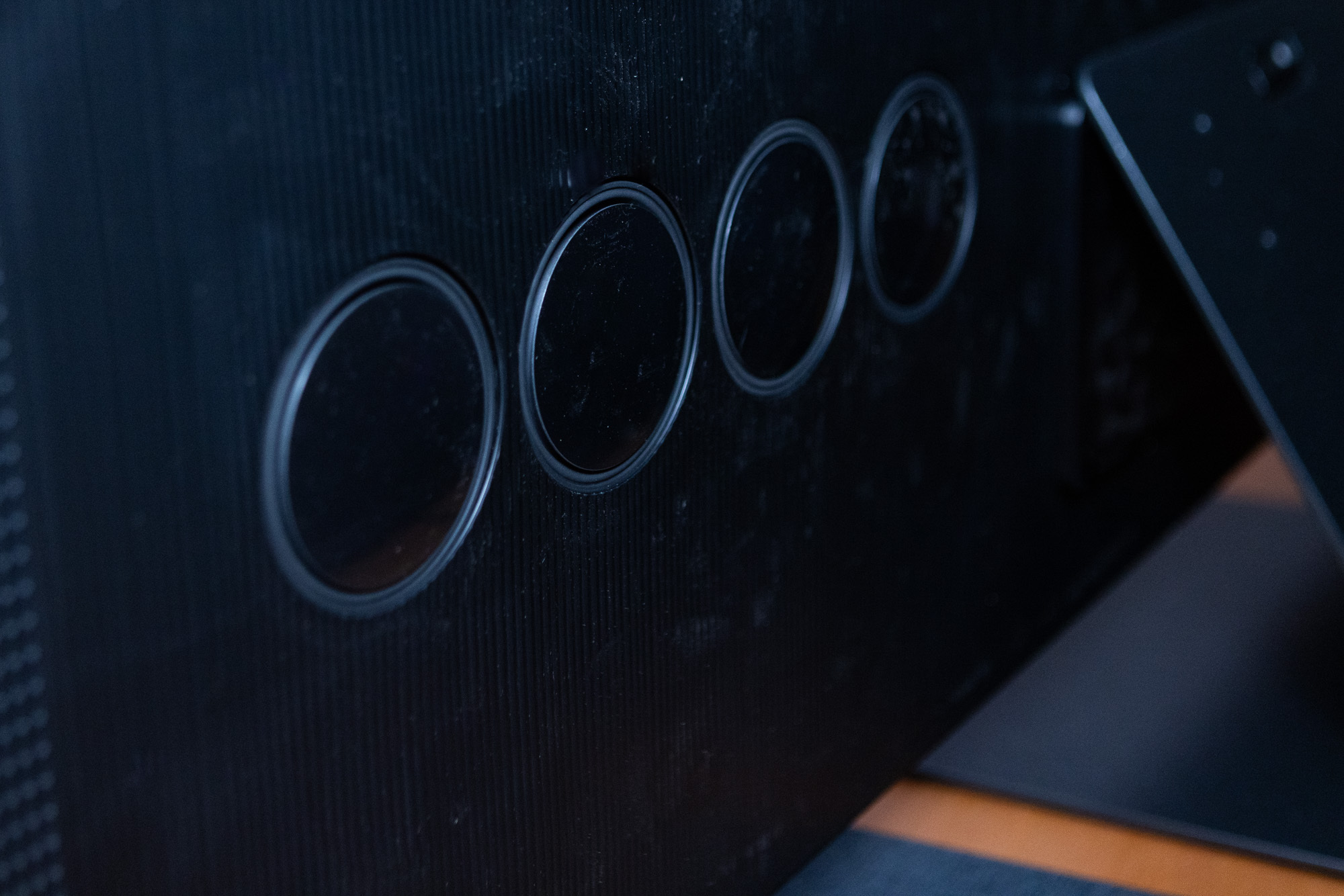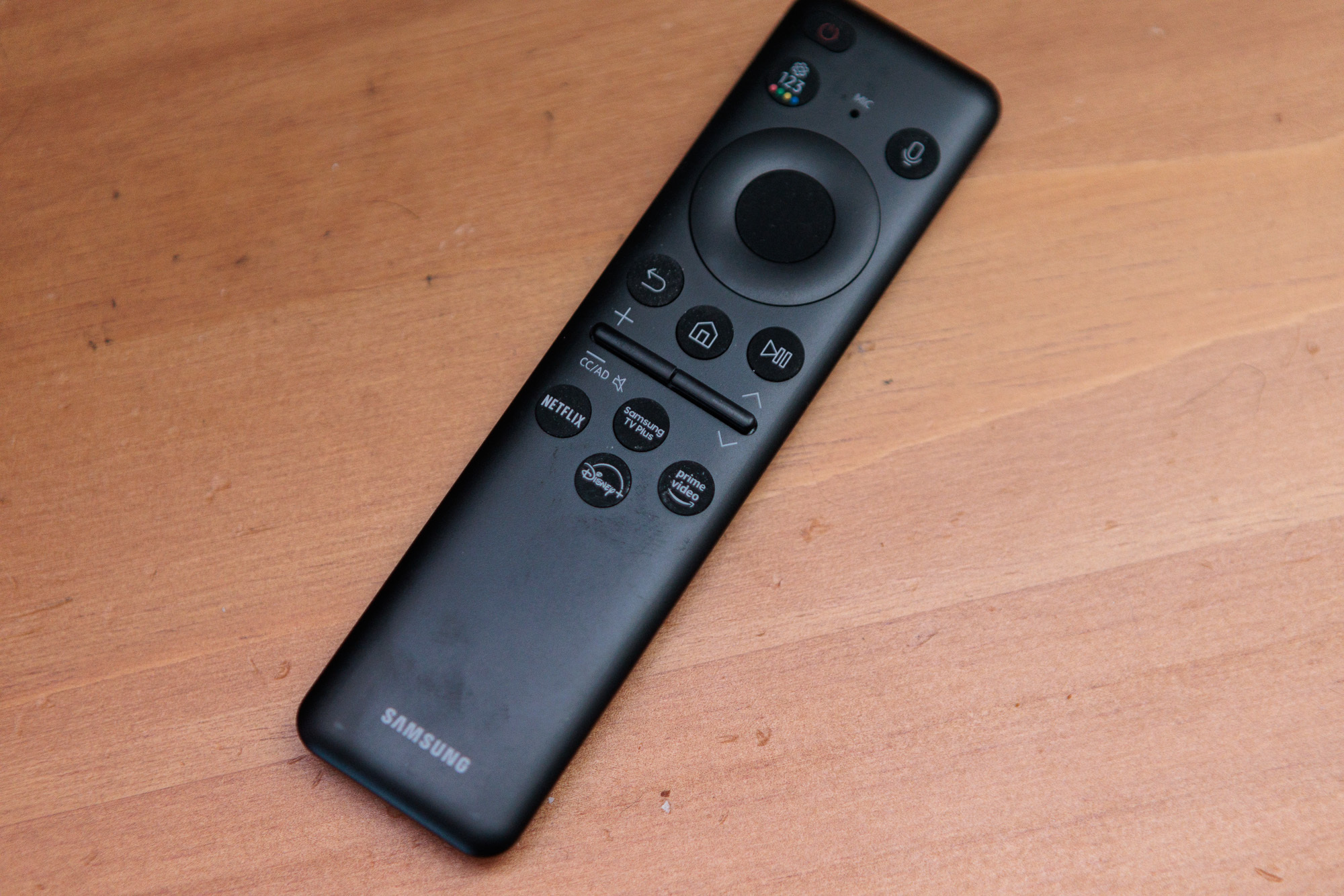Samsung S95D QD-OLED TV review: Stunning in any setting
We may earn revenue from the products available on this page and participate in affiliate programs. Learn more ›
My living room isn’t well-suited for testing OLED TVs. There’s a pair of large windows off to the side of the viewing area, and when they’re not busy leaking, they’re letting in enough ambient light to wash out a typical OLED. This type of TV excels in contrast and color reproduction but can only pump out comparatively paltry max brightness levels. That makes even a moderately bright room a no-go. And let’s be honest, that’s what most of us have. So, instead of appealing just to people with perfectly treated home theaters, Samsung aimed to fix that issue with its new S95D QD-OLED TV. And after a few weeks spent watching content and gaming to the best of my very pathetic abilities, I can confirm it as a huge success. The S95D’s defining feature may have caused some controversy in the hardcore AV world (more on that later), but it’s easily one of the best TVs I’ve ever seen.
Specs
- Resolution: 4K
- Refresh rate: 144Hz
- Sizes: 55”, 65”, and 77”
- OS: Tizen
- HDMI ports: Four HDMI 2.1 ports
- Wireless: Wi-Fi 5
- Bluetooth: BT5.2
- Processor: NQ4 AI Gen2 Processor
Pros
- Excellent color accuracy and contrast, as you’d expect from OLED
- Exceptional brightness thanks to Quantum Dot tech
- Anti-glare coating works phenomenally
- Ports and connectors live on a box connected to the display by a single wire for flexible installation
- Built-in speakers provide clear, crisp audio that makes dialog easy to hear (credit to Samsung processing)
- Low input lag
- Responsive operating system
Cons
- Anti-glare tech comes with very slight compromises in terms of pure picture quality
- While the speakers provide excellent clarity, they’re not overly powerful
Verdict: Just about every OLED TV looks phenomenal in the dark, but the S95D’s ability to shine (literally) in a room full of ambient light makes it one of the most impressive pieces of TV technology to come around in years.
How I tested the Samsung S95D QD-OLED TV
I have been writing about and reviewing TVs for roughly two decades for outlets including this one, Men’s Journal, Sound & Vision, AOL, and others. For this test, I placed the Samsung S95D QD-OLED TV directly in front of my typical TV to get a true real-world experience. I played regular Blu-rays, 4K Blu-rays, and games through a PlayStation 5. I also connected the TV to my Wi-Fi router and compared content through the native Samsung apps with the most recent Apple TV 4K (my preferred hardware for streaming media).
We do some scientific testing on equipment like this, but we don’t publicly post the results because we don’t control the environment in a way to capture publishable results. I use a Datacolor Spyder X Pro device to measure brightness and color accuracy as a reference for our internal testing. Other sites provide excellent test results from labs, but that information doesn’t always reflect the real-world experience that comes from watching a TV.

The Samsung S95D’s picture quality
There’s a lot about the ultra-slim S95D that’s impressive and we’ll get into the build below, but we’re here first and foremost for the panel’s picture quality. If you’re spending the extra money for an OLED, it’s for the on-screen image.
Brightness
Brighter isn’t always better. Even casual TV snobs know this fact. But, the S95D changes the math on that old rule. The first time I turned on our review unit, I couldn’t believe how much light it put out. I was standing in my sunny living room at two in the afternoon, and this OLED display was blasting over the ambient light without hesitation. The S95D is noticeably brighter than its predecessor or really any OLED TV I’ve ever seen. It’s brighter than the middle-of-the-road LG TV I bought on Black Friday a few years ago to use between TV reviews. The S95D is just plain bright and truly improves its overall performance.
In addition to the increased light output, the S95D is the first TV non-Frame-series TV to get the full anti-glare treatment, which was a standout feature in our first impressions and remains one now that we’ve gotten to try the TV outside of an impromptu showroom setting. As a result, the screen has a more matte appearance than its glossy ancestors and competition—in the high-end printing world, I’d call this a pearl finish. Even with the TV off, it’s apparent just how well the surface resists reflections. Even bright objects, which would typically render as a sharp reflection on a glossy screen, wash out to a dull, nebulous blob. The turtle tank with a UV light that typically occupies a full quarter of my TV screen when it’s turned on? Pretty much gone. I’m impressed.
Even when a light shines directly onto the surface, the anti-glare surface renders it nearly invisible. This does come at a slight cost. As some other reviewers have noted, the anti-glare makes the perceived black level seem a bit brighter than a glossy screen would. Thus, the controversy mentioned in the intro. But, the benefits will drastically outweigh that tiny complaint for the majority of the TV-watching public. The anti-glare tech seriously changes the OLED game.

Bring on the content
For the early tests, I left the TV in standard mode, which doesn’t quite max out the TV’s light output, but it’s decidedly more luminous than the more subdued movie mode or Filmmaker Mode. All the typical OLED benefits shine through immediately. I popped in a Blu-ray of Venom: Let There Be Carnage, which isn’t a great film, but it’s a meat grind of a test for just about any TV. Its extremely high contrast, fast motion, and vivid colors quickly expose a TV’s shortcomings. The S95D handled it all with aplomb.
I like Filmmaker Mode, which is designed to depict the movie as the creators intended. But it’s typically only usable in very dark situations. I still preferred standard, or maybe movie mode for viewing content while the sun was up, but Filmmaker Mode was still totally viable. You can be a snob at any time of day.
I put on the first Timothée Chalamet Dune movie out of pure curiosity. In a dark room with standard mode turned on, the jarring dark-to-bright transitions from dingy interiors to blazing desert scenery were enough to make me wince, literally. That’s the kind of impact I like to see.
Those transitions are also a great test for a TV like this. Going from bright to dark doesn’t leave any lingering brightness. Bright don’t bleed into dark areas next to them (a phenomenon called blooming) to ruin the overall clarity of the image.
A little help from AI
You can’t get away from AI in the gadget world and this TV is no exception. The S95D comes toting Samsung’s latest image processing chip, which puts a heavy emphasis on AI. Multiple neural networks analyze every single image and frame to emphasize subjects, upscale the picture, and improve audio performance.
Even as a TV reviewer, I still watch streamed content more than pristine 4K Blu-rays. I imagine you’re the same way. Luckily, my review unit arrived just as the new Fallout series premiered on Amazon Prime. Like Dune, the post-apocalyptic series jumps freely between dingy underground silos and sun-blasted desert landscapes. The S95D, once again, excelled. The deep blacks retain tons of detail, though just slightly less than a high-end Mini-LED (like Samsung’s own QN900/D). But the inkiest blacks are why you go OLED. You want that contrast, and the S95D dishes it out in spades. The streamed image looked excellent. I again found myself defaulting to standard picture mode because it feels like it uses more of the panel’s dynamic range without losing anything.
When it comes to 4K upscaling, the S95D does a great job across the board. The final result will vary depending on the bitrate and quality of the original content (don’t even try to watch Buffy the Vampire Slayer on Amazon Prime because no amount of AI can save that mess) but don’t expect extra artifacts or other upscaling nastiness to become apparent very often if at all.
Gaming performance
Several features apply specifically to gaming performance, including the maximum 144Hz effective refresh rate. For this test, I jumped into Helldivers 2 on the PS5. While it’s not the pinnacle of graphical achievements in terms of gaming, it is a challenging title thanks to tons of fast-moving on-screen objects and shadowy environments.
Input lag is nearly non-existent, essential if you want a good gaming TV. Response times are also miniscule, which fares well for fast on-screen action. I died—a lot—during the test session, but I looked great doing it. The TV will automatically enable game mode when you start gaming, and you’re best served to leave it be once it makes the switch. That’s how it unlocks game-specific features like the maximum refresh rate and the lowest possible input lag.

The Samsung S95D’s sound
While OLEDs often excel in terms of picture quality, their super-thin panels don’t leave much room for audio firepower. Samsung made hay with the space it had in the S95D, packing a total of eight circular speakers onto the back of the display. They won’t blow you away with power, especially on the low end, but Samsung has emphasized its strengths, which are clarity and understandability. The AI-powered chip enables Dolby Atmos compatibility and localized audio, which creates a discernible directional audio effect depending on which on-screen object is making noise. You can hear a spaceship zoom across the screen. It’s not nearly as pronounced as with a true surround sound system, but it’s noticeable and appreciated.
Even cranked to max volume, the speakers don’t offer much in terms of crackle or distortion. The voice clarification tech really does make a difference, though, which is handy for people like me who have trouble hearing words through ambient noise.
Overall, the sound performance is solid, but with a TV this nice, you’re doing yourself a disservice by not adding a more powerful stand-alone system to the mix. [Related: Look for our review of Samsung’s new flagship wireless soundbar system, the HW-Q990D, coming very soon.]
The Samsung S95D’s design and setup
Another impressive aspect of the S95D is that this deep feature set fits in a strikingly shallow enclosure thanks to thoughtful design decisions. As a high-end TV, Samsung didn’t skimp on the S95D’s build quality. The panel connects via a single wire to a compact interface containing all the necessary ports and connections. The “One Connect Box” is about the size of a stand-alone DVD player and can sit horizontally or wall mount vertically. I chose to use the included stand instead of putting the display on a mount, though I could have easily mounted it thanks to VESA compatibility. The bezel is skinny. The panel is flat. The external I/O box is a nice touch. The setup and build quality really didn’t give me anything to complain about.
I can’t say quite the same thing about the remote. I love that the Samsung remote charges via the onboard solar panel, but I still find the layout annoying. The flat rocker buttons for channel and volume changes aren’t designed for my clumsy hands. The remote is also tiny and somewhat non-descript, so it’s easy to lose it in a pile of other remotes (though that may only be a problem if you’re also a reviewer with too many remote-controlled devices).

So, who should buy the Samsung S95D?
If you’ve been craving the contrast and color accuracy that comes with OLED but are worried your space is too bright, then your worries are over. The extra brightness and the very impressive anti-reflective coating have truly changed the game. With help from Samsung’s new AI-powered image processor, the S95D QD-OLED creates one of the best viewing experiences of any TV I’ve tested.
